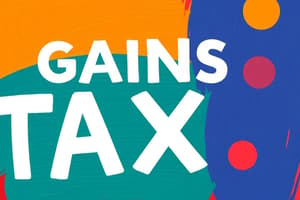Podcast
Questions and Answers
The total amount received from selling an asset is known as the ______.
The total amount received from selling an asset is known as the ______.
Disposal Proceeds
Costs related to the sale, such as legal fees or agent fees, are referred to as ______.
Costs related to the sale, such as legal fees or agent fees, are referred to as ______.
Incidental Costs of Disposal
The cost of acquiring the asset and any improvements made to it is known as ______.
The cost of acquiring the asset and any improvements made to it is known as ______.
Allowable Expenditure
Any capital losses from previous years or the same tax year that can be offset against the gain are called ______.
Any capital losses from previous years or the same tax year that can be offset against the gain are called ______.
The CGT allowance that individuals can use to reduce their taxable gain is known as ______.
The CGT allowance that individuals can use to reduce their taxable gain is known as ______.
The final amount on which CGT is calculated after all deductions is called ______.
The final amount on which CGT is calculated after all deductions is called ______.
To remember the sequence of CGT computation for individuals, the mnemonic used is ______.
To remember the sequence of CGT computation for individuals, the mnemonic used is ______.
Match the components of CGT computation with their descriptions:
Match the components of CGT computation with their descriptions:
Match the terms related to CGT computation with their meanings:
Match the terms related to CGT computation with their meanings:
Match the CGT computation steps with their order in the process:
Match the CGT computation steps with their order in the process:
Match the CGT aspects to their corresponding details:
Match the CGT aspects to their corresponding details:
Match the definitions with the CGT terms:
Match the definitions with the CGT terms:
Match the types of costs with their CGT computation role:
Match the types of costs with their CGT computation role:
Match the mnemonic components to their meanings in CGT:
Match the mnemonic components to their meanings in CGT:
Match the steps of CGT computation with their correct sequence:
Match the steps of CGT computation with their correct sequence:
Match each CGT component with its definition:
Match each CGT component with its definition:
Match the deduction type with its explanation in CGT computation:
Match the deduction type with its explanation in CGT computation:
Match the terms of the CGT computation with their roles:
Match the terms of the CGT computation with their roles:
Match the mnemonic components to their meanings in CGT process:
Match the mnemonic components to their meanings in CGT process:
Match the elements of CGT deduction with their sequence:
Match the elements of CGT deduction with their sequence:
Match each component of CGT computation with the adjustment it provides:
Match each component of CGT computation with the adjustment it provides:
Match the terms in CGT with their correct descriptions:
Match the terms in CGT with their correct descriptions:
Match the definitions related to CGT with the correct term:
Match the definitions related to CGT with the correct term:
Flashcards are hidden until you start studying
Study Notes
CGT Computation for Individuals
- Starting Point: Disposal Proceeds - The total amount received from selling an asset.
- Deductions:
- Incidental Costs of Disposal: Costs related to the sale, such as legal fees or agent fees.
- Allowable Expenditure: The cost of acquiring the asset and any improvements made to it.
- Capital Losses: Any capital losses from previous years or the same tax year that can be offset against the gain.
- Annual Exemption: The CGT allowance that individuals can use to reduce their taxable gain (e.g., £3,000 for 2024/25).
- Final Calculation: Taxable Gains - The final amount on which CGT is calculated, after all deductions.
Mnemonic for CGT Computation
- DIA-CAT:
- D: Disposal Proceeds
- I: Incidental Costs
- A: Allowable Expenditure
- C: Capital Losses
- A: Annual Exemption
- T: Taxable Gains
CGT Computation for Individuals
- Disposal Proceeds: The initial amount received from selling an asset.
- Incidental Costs of Disposal: Costs directly associated with the sale, such as legal fees or agent fees. These costs are deducted from the disposal proceeds.
- Allowable Expenditure: Includes the original cost of acquiring the asset and any improvements made to it. This expenditure is subtracted from the remaining amount after incidental costs.
- Capital Losses: Losses from previous asset disposals, either in the same tax year or from previous years, can be deducted to offset any capital gains.
- Annual Exemption: A yearly allowance provided to individuals to reduce their taxable capital gains (e.g., £3,000 in 2024/25). This exemption is applied after capital losses.
- Taxable Gains: The remaining amount after all deductions (disposal proceeds, incidental costs, allowable expenditure, capital losses, and annual exemption) is the taxable gain on which CGT is calculated.
Mnemonic for Individuals (DIA-CAT)
- The mnemonic DIA-CAT helps remember the steps for calculating Capital Gains Tax (CGT) for individuals:
- D: Disposal Proceeds
- I: Incidental Costs
- A: Allowable Expenditure
- C: Capital Losses
- A: Annual Exemption
- T: Taxable Gains
CGT Computation for Individuals
- The CGT computation begins with Disposal Proceeds, the total amount received from selling an asset.
- Incidental Costs of Disposal such as legal fees or agent fees are deducted.
- Allowable Expenditure, representing the original cost of acquiring the asset and any improvements made to it, is further deducted.
- Capital Losses incurred in previous years or the same tax year can be offset against the gain.
- The Annual Exemption allows individuals to deduct a certain amount from their taxable gain, reducing their CGT liability.
- The remaining amount is the Taxable Gains, upon which CGT is calculated.
Mnemonic for CGT Calculation
- The mnemonic DIA-CAT helps remember the order of deductions:
- D: Disposal Proceeds
- I: Incidental Costs
- A: Allowable Expenditure
- C: Capital Losses
- A: Annual Exemption
- T: Taxable Gains
Flashcard Questions and Answers
- What is the starting point of the CGT computation for an individual?
- Disposal Proceeds: The amount received from selling the asset.
- What is deducted after disposal proceeds in the CGT computation?
- Less: Incidental Costs of Disposal: Legal fees, agent fees, and other costs directly related to the sale.
- What comes after incidental costs of disposal?
- Less: Allowable Expenditure: The original cost of acquiring the asset and any costs for improvements.
- Which losses can be deducted after allowable expenditure?
- Less: Capital Losses: Losses from previous disposals that can offset gains.
- What is the annual deduction available to reduce the taxable gains?
- Less: Annual Exemption: The annual CGT allowance for individuals (e.g., £3,000 for 2024/25).
- What is the final amount on which CGT is charged called?
- Taxable Gains: The final amount after all deductions, on which CGT will be calculated.
Studying That Suits You
Use AI to generate personalized quizzes and flashcards to suit your learning preferences.



